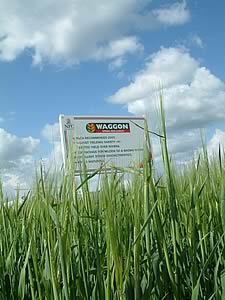 |
|||||||||
|
|||||||||||||||||||||||||||||
Barley
trials show straw yield may not be linked to length Spring barley growers using straw length or height as a guide to varieties that will give them the greatest straw yield may not be using the best indicator, independent farm trials managed by Scottish Agronomy suggest.
Conducted near Forfar, the first trial compared three feed spring barley varieties each with different crop heights on the HGCA Recommended List 2006 – Waggon at 74 cm, Doyen at 71 cm and Riviera at 82 cm. At least 1 ha of each was grown, and both grain and straw yield measured at harvest. But instead of showing that straw yield increased with increasing straw height, findings revealed it was more closely correlated with grain output. The tallest variety Riviera produced the lowest straw output at 3.5 t/ha, and also had the lowest grain yield at 6.3 t/ha. Meanwhile the shortest variety Doyen produced the middle straw output of 3.8 t/ha, and at a grain yield of 7.0 t/ha. But the highest straw yield of all, at 4.8 t/ha, came from newcomer Waggon, which produced 7.6 t/ha of grain. A second trial, comparing Waggon and Doyen with spring malting variety Chalice, currently being grown as an early maturing feed type, also showed that straw output increased with increasing grain yield. “Common perception is that tall strawed varieties produce more straw than short ones,” explains Scottish Agronomy managing director, Andrew Gilchrist. “I know from experience that’s not the case. Waggon is an example of a new feed variety that is relatively short and stiff – as is Doyen. “Where you’ve got livestock in the enterprise it’s quite a bonus if you produce more straw,” he points out. According to Simon Phillips, technical manager for breeder Syngenta Seeds, who supplied seed of Waggon and Doyen for the work, results could challenge many growers’ thinking. “In this work, growing a shorter variety actually gave 1.3 t/ha more straw. At a straw price of say £20-70/t, depending on time of year and location, that’s an extra £26 – £91/ha return for the grower. That’s without taking into account the extra grain.” On the face of it, Mr Phillips admits these findings appear to go against conventional wisdom. “But actually they’re logical,” he stresses. “In order to produce a high grain yield, a plant needs lots of biomass. And lots of biomass means lots of straw. It’s got nothing to do with height whatsoever. “With barley straw being so valuable, straw height has been a big factor in determining variety choice on many farms. Now, perhaps growers will question whether this is the right thing to look at,” he adds. Feed spring barley – results of straw yield trial
Source: Scottish Agronomy, Forfar
|
|||||||||||||||||||||||||||||

|
|
||||||||||||||||||||||||||||
| home | agri-services | pedigree
pen | news | dairy | beef | machinery BPS | property | organisations | site map |
|||||||||||||||||||||||||||||
